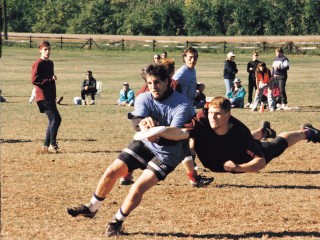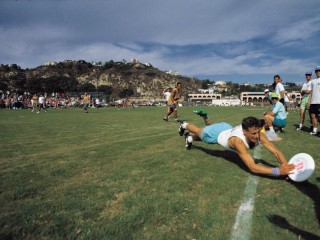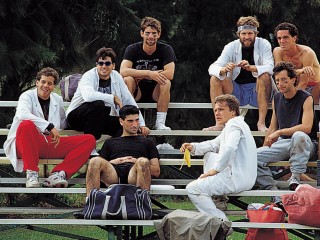The following piece is from Ultimate: The First Four Decades, available now in ebook form.
Virtually every ultimate player in the world has a forehand and a hammer these days. But it wasn’t always that way. When ultimate began in the late 1960s and early 1970s, no one used either throw. Backhands and overhand wrist flips were the order of the day.
“I threw backhands, backhands, backhands,” said the 6-foot-6, Dan “Stork” Roddick, who played with the Rutgers dynasty of the early 1970s and later became the director of the International Frisbee Association (IFA). “I never threw a single pass for Rutgers that wasn’t a backhand.”
So who pioneered the forehand? What about the hammer?
Victor Malafronte had a hand in both. A cocky former marine ammo technician from Brooklyn, who won the overall men’s World Frisbee Championship at the Rose Bowl in 1974 and later toured with the Harlem Globetrotters, Malafronte is the father of the modern forehand. Jim Pistrang of Tufts and Irv Kalb of Rutgers learned the throw from him and popularized it on the East Coast, while others, such as Reach Helmka, helped spread it in the West. Malafronte also used the hammer well before anyone else, though Penn State’s Roger Shepard, and Cornell’s Jim Herrick and Paul Brenner are credited with introducing it to ultimate.
Malafronte pioneered the forehand after learning it at Berkeley’s Sproul Plaza in 1968, when he was a creative arts student at San Francisco State. He watched a couple of guys named Dave Book and Chuck Pitt throw a standard “sidearm” and also one that was released behind the back. By 1969, he and Stancil Johnson were throwing sidearms at each other in a Guts competition at the International Frisbee Tournament (IFT) in Michigan; Johnson, author of the seminal 1975 book Frisbee: A practitioner’s manual and definitive treatise, had learned the throw during the early 1960s.
By the early 1970s, Malafronte had termed his throw the “two-finger macho sidewinder” and was teaching it to others.
“I had the best sidearm going,” he said. “Nobody could match me. I have taught so many people how to throw a sidearm because it was much easier for them to throw a backhand. Many people were using just their index finger. I said, ‘You need two fingers in here to get a good grasp on your disc.’”
“He had what could be argued the best sidearm ever,” added Roddick. “It’s so odd that the first guy has turned out to be the best. What are the odds?”
Until that time, Kalb and his friends from Columbia High School had relied on the backhand and the overhand wrist flip. Kalb was so proficient at the wrist flip that Al Jolley of Staples High School in Connecticut nicknamed it the “Jersey throw.”
Kalb, who became the Rutgers captain after graduating high school, and his crew had only heard about the mysterious “sidearm” throw through the IFA’s instruction manual. They attempted it, but when it fell to the ground after 25 yards, they gave up. They also figured it would be easy to block.
“We had seen this thing written up in the IFA manual, but we thought it was a joke,” said Kalb. “We were happy with the overhand wrist flip.”
About this time, Pistrang, who co-founded the Tufts team with Ed Summers in 1972, began experimenting independently with the sidearm.
“It just seemed obvious that the throw should work,” Pistrang recalled. “It was obvious that being able to throw from both sides of your body would be advantageous in ultimate. We knew theoretically that it would work, but we had never seen it done and couldn’t quite get it.”
One summer, Kalb, Pistrang, Summers and Larry Schindel, who had also learned ultimate at Columbia High School, attended the IFT, hoping to “spread the Gospel” of ultimate to the Guts crowd.
Then they saw Malafronte actually use the “macho sidewinder” with great success. When Kalb saw Malafronte chuck a 110-gram Pro model 100 yards or better, he thought the man’s hand or wrist must have been deformed in some way. They jokingly referred to him as “Victor Malformed.”
“We were just blown away,” Kalb recalled.
Added Pistrang: “I remember that what had the biggest impression on me was his arm motion, the snap he put into the throw, and the speed of the release.
“Victor Malafronte handled 108 grams of pure polyethelene like no other man in the world, and he made it look easy!”
Malafronte later played competitive ultimate in northern California, but never pursued it full-time.
Motivated by his meeting with Malafronte at the IFT, Pistrang then began perfecting the sidearm, using it mainly as a short release or dump throw. He is widely regarded as the first to use the forehand on the East Coast ultimate scene.
“Pistrang was an ultimate player, and he recognized the value of being able to throw from both sides, and understood how to apply this new throw he was working on,” recalled former Cornell captain, Jon Cohn, known as “JC.”
And once Kalb, known as “Dr. I,” began using the forehand, the throw became even more popular.
“The Columbia-bred founders didn’t convert to throwing it until Irv started throwing it,” Cohn said. “Pretty much everyone on those first college teams learned from their respective founders. Every one of us strove to emulate Irv. He was far and away the best player in the early 1970s.”
In the West, Malafronte taught the throw to people such as Helmka, who spread it to his San Jose Cling’ons teammates and others within the Northern California Ultimate League, a 16-team conference including teams in California and Oregon.
As for the hammer, Malafronte and his partner, John Kirkland, first wowed crowds with it during a 24-minute halftime show at Globetrotter games during the mid-1970s. The duo put their act on in 180 cities in six months, a different city every night. They were even featured in a 1975 Sports Illustrated article.
During the mid-1970s, Roger Shepard of Penn State also began experimenting with surgical overhead throws when his team played indoors. Shepard would also go on to pioneer the famed “Stanford Offense.”
It took several years before the hammer became common in ultimate. Herrick of Cornell suspects he may have seen it at the 1976 World Championships at the Rose Bowl. He then taught it to Brenner in Cornell’s Barton Hall, and eventually to players on Boston Aerodisc and the Rude Boys. When Brenner became a primary handler in 1980, he began regularly using the throw as a zone-buster. The benefit of the hammer, of course, is that the thrower can go over the defense, as opposed to through it, by dropping in a throw almost anywhere on the field.
“I was certain that the future of ultimate would involve vertical throws because they eliminated the float factor, could be thrown harder and could thereby annihilate zones,” Herrick said. “The problem at that time wasn’t throwing them. It was catching. While guys like Brenner readily understood that all you had to do was commit, practice and launch yourself aggressively for a vertical pancake, most others couldn’t handle them.”
A decade later, Ken Dobyns and Dennis “Cribber” Warsen of New York put on a hammer clinic in the finals of the 1993 Worlds in Madison, Wisconsin. Against San Francisco’s Double Happiness, and in a stadium filled with fans, the two New Yorkers chucked jaw-dropping, full-field hammers over the defense for several goals as New York won the title.
Chris Jones, who played at Williams College, is considered by some to have the best pure hammer ever. Jones, who played for New York’s Graffiti and Cojones, has a completely unique style in which his hammer seems to float out in front of the receiver, much like a forehand or backhand.
Taro Ramberg, who won two national championships with the Santa Barbara Condors, also possesses one of the most effective, and unique, hammers in the business. A former shortstop at the high school and minor league levels, Ramberg throws a line drive hammer, much like the throw a shortstop makes to first base.
Still, Dobyns, Jones, Ramberg and anyone else who throws the overhead must account for the wind, just like Herrick did.
“So many times you would see a guy wide open for the hammer sitting in an open spot, and you’d throw it and then realize the strong left to right wind pushed it 20 yards right,” Herrick said. “I suspect that is still going on.”
It sure is.
Ultimate: The First Four Decades is available now for purchase on Google Books.








Comments Policy: At Skyd, we value all legitimate contributions to the discussion of ultimate. However, please ensure your input is respectful. Hateful, slanderous, or disrespectful comments will be deleted. For grammatical, factual, and typographic errors, instead of leaving a comment, please e-mail our editors directly at editors [at] skydmagazine.com.